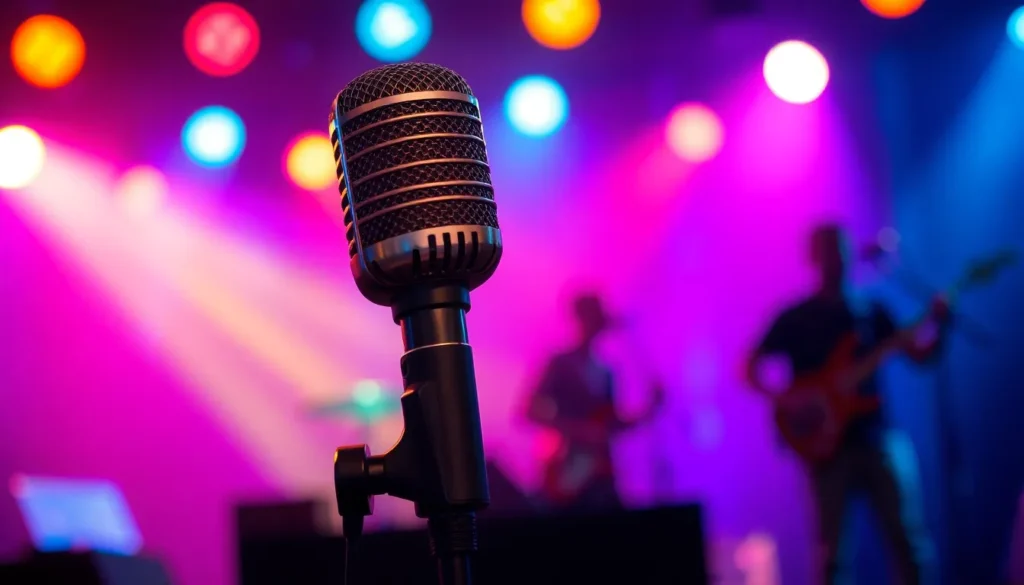Table of Contents
ToggleDynamic microphones are the unsung heroes of the audio world, ready to capture every note and nuance with unwavering reliability. Whether it’s a rock concert or a podcast recording, these little powerhouses deliver crisp sound while shrugging off background noise like a champ. Who needs a diva-like condenser mic when you’ve got a dynamic mic that can handle the rough and tumble of live performances?
Imagine belting your favorite tune on stage, and your dynamic microphone stands firm, refusing to let feedback ruin the moment. It’s like having a loyal sidekick that never lets you down. With their durability and versatility, dynamic microphones are the go-to choice for musicians, broadcasters, and anyone who craves top-notch audio without the fuss. Dive into the world of dynamic microphones and discover why they’re the secret weapon in every sound engineer’s toolkit.
Overview of Dynamic Microphones
Dynamic microphones excel in both durability and performance, making them a popular choice among professionals. These microphones employ a moving coil design, which translates sound vibrations into electrical signals. Exceptional sound quality characterizes them, particularly in live settings where clarity remains paramount.
Built to endure rigorous conditions, dynamic microphones resist moisture and physical impacts, appealing to musicians and sound engineers. Many rely on their low sensitivity to ambient noise, allowing for focused capture during performances. Vocalists often select dynamic mics for their ability to handle high sound pressure levels without distortion.
Versatility defines dynamic microphones; they find application in various audio settings, from concerts to studio recordings. A wide range of frequency response allows them to capture everything from deep vocals to high-frequency instruments effectively. Specific models, like the Shure SM58 and Sennheiser e835, highlight the effectiveness of dynamic microphones in different scenarios.
User-friendly features further enhance their appeal. Often, dynamic microphones connect directly to mixers, making setup straightforward. Simplicity and reliability combine to make them an essential tool for audio professionals. Performance consistency across environments positions dynamic microphones as a staple in the industry.
Dynamic microphones thrive in both stage and studio applications, offering unmatched adaptability. They serve as dependable companions, balancing sound quality with practicality, ensuring audio engineers achieve the best results in diverse situations.
How Dynamic Microphones Work

Understanding dynamic microphones involves examining their essential components and the sound conversion process. These microphones are designed for reliability in various audio environments.
Components of Dynamic Microphones
Dynamic microphones consist of a diaphragm, voice coil, and magnet. The diaphragm captures sound waves, transforming them into mechanical vibrations. This diaphragm is typically made of thin, lightweight materials that enhance responsiveness. A voice coil attached to the diaphragm interacts with a magnetic field produced by the magnet. This assembly provides durability, crucial for live performances and rigorous setups. The entire design ensures that dynamic microphones can withstand impacts and moisture, making them suitable for on-stage use.
Sound Conversion Process
The sound conversion process in dynamic microphones begins when sound waves strike the diaphragm. These waves cause the diaphragm to vibrate, which in turn moves the attached voice coil within the magnetic field. This movement produces an electrical current, representing the sound waves. The generated electrical signal retains the original sound’s characteristics, allowing for high-quality audio reproduction. This process captures vocals effectively, providing crystal-clear output even in loud environments. Dynamic microphones excel in high sound pressure levels, making them ideal for various applications such as concerts and broadcasting.
Advantages of Dynamic Microphones
Dynamic microphones offer significant benefits, especially for live sound applications. Their robust design ensures reliability and performance in various environments.
Durability and Build Quality
Durability stands out as a primary feature of dynamic microphones. Designed to withstand rigorous conditions, they resist moisture and physical impacts, making them ideal for touring musicians and sound engineers. Components like the diaphragm and body are constructed for longevity. These microphones continue to perform even after extended use and exposure to challenging conditions. Users appreciate their ability to function consistently without the worry of damage from handling or environmental factors. The sturdy construction allows for regular transport without risking failure.
Performance in Live Settings
Performance in live settings showcases the strengths of dynamic microphones. Exceptional sound quality shines through in loud environments, where they handle high sound pressure levels without distortion. Vocalists find dynamic microphones easy to use, as they capture focused audio while minimizing background noise. These microphones remain less sensitive to ambient sounds, which enhances overall clarity during performances. Additionally, specific models, like the Shure SM58 and Sennheiser e835, exemplify outstanding audio fidelity under stage conditions. Their user-friendly setup simplifies the connection to mixers and live sound systems, allowing for seamless integration during events.
Disadvantages of Dynamic Microphones
Dynamic microphones exhibit several disadvantages despite their many advantages. Understanding these limitations is crucial for selecting the right microphone for specific applications.
Limited Frequency Response
Limited frequency response characterizes dynamic microphones, as they generally struggle to capture high and low frequencies effectively. These microphones tend to excel in the mid-range, which is great for vocals but might not deliver the full sonic spectrum required for some instruments. A broader frequency response is often found in condenser microphones, making them more suitable for studio recordings. Musicians seeking detailed sound reproduction might find dynamic mics lacking, particularly in capturing the nuances of acoustic guitars or cymbals. Therefore, identifying the right mic for the task at hand involves considering the frequency needs of the audio source.
Sensitivity to Sound Pressure
Sensitivity to sound pressure levels becomes a concern with dynamic microphones when it comes to loud noises. While they handle high SPL well, excessive sound can push them beyond their limits, potentially causing distortion. This distortion can hinder the clarity of the audio being captured, impacting the overall sound quality. In environments where sound levels frequently spike, such as live concerts, this drawback can be particularly pronounced. Condenser microphones typically perform better in such situations due to enhanced sensitivity. By understanding these limitations, sound engineers can make informed decisions about microphone selection in diverse audio settings.
Popular Dynamic Microphone Models
Dynamic microphones stand out in diverse audio settings. Their affordability, reliability, and performance have made them popular choices among audio professionals. Below are two widely recognized dynamic microphone models.
Shure SM58
Shure SM58 ranks among the most iconic dynamic microphones. This model features a robust design that excels in live performances, offering excellent vocal clarity. Built with a spherical mesh grille, it effectively minimizes plosive sounds, ensuring clean audio capture. Its frequency response tends to emphasize vocals, making it ideal for singers on stage. The rugged construction guarantees it withstands impacts and moisture, key for touring musicians. Users appreciate the SM58’s ability to handle high sound pressure levels without distortion, maintaining audio integrity in loud environments. Overall, its reputation for durability and performance makes the Shure SM58 a top choice.
Sennheiser e835
Sennheiser e835 emphasizes versatility and sound quality. This dynamic microphone excels in both live settings and studio recordings. Featuring a tailored frequency response, it captures vocals with clarity and warmth, appealing to a broad range of performers. The e835’s design incorporates a cardioid pickup pattern, effectively rejecting background noise while focusing on the desired sound source. Its sturdy construction ensures reliability, making it suitable for various environments. Users find the e835 easy to integrate with different audio setups due to its straightforward connectivity. Overall, the Sennheiser e835 balances performance and durability, catering to musicians and sound engineers alike.
Dynamic microphones stand out in the audio landscape for their reliability and performance. Their robust design ensures they can withstand the rigors of live settings while delivering clear sound. Musicians and sound engineers alike appreciate their ability to minimize background noise and handle high sound pressure levels without distortion.
Despite some limitations in frequency response, dynamic mics like the Shure SM58 and Sennheiser e835 continue to be favored choices for various applications. Their user-friendly features and versatility make them indispensable tools in both live performances and studio recordings. Understanding their strengths and weaknesses allows users to make informed decisions, ensuring optimal sound quality in any environment.







